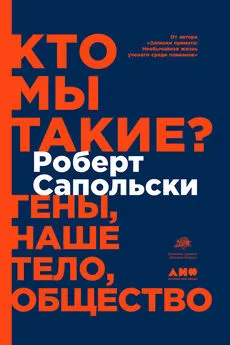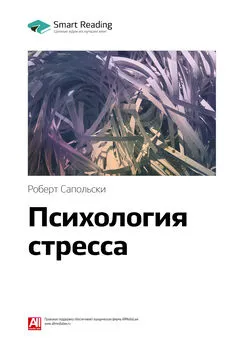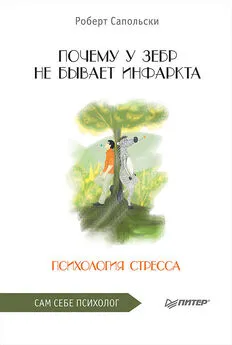Роберт Сапольски - Биология добра и зла. Как наука объясняет наши поступки
- Название:Биология добра и зла. Как наука объясняет наши поступки
- Автор:
- Жанр:
- Издательство:Альпина нон-фикшн
- Год:2019
- Город:Москва
- ISBN:978-5-0013-9051-0
- Рейтинг:
- Избранное:Добавить в избранное
-
Отзывы:
-
Ваша оценка:
Роберт Сапольски - Биология добра и зла. Как наука объясняет наши поступки краткое содержание
Биология добра и зла. Как наука объясняет наши поступки - читать онлайн бесплатно ознакомительный отрывок
Интервал:
Закладка:
L. Rhue and A. Sundararajan, “Digital Access, Political Networks and the Diffusion of Democracy,” Soc Networks 36 (2014): 40.
949
M. Inzlicht et al., “Neural Markers of Religious Conviction,” Psych Sci 20 (2009): 385; M. Anastasi and A. Newberg, “A Preliminary Study of the Acute Effects of Religious Ritual on Anxiety,” J Alternative and Complementary Med 14 (2008): 163.
950
U. Schjoedt et al., “Reward Prayers,” Nsci Letters 433 (2008): 165; N. P. Azari et al., “Neural Correlates of Religious Experience,” Eur J Nsci 13 (2001): 1649; U. Schjoedt et al., “Highly Religious Participants Recruit Areas of Social Cognition in Personal Prayer,” SCAN 4 (2009): 199; A. Norenzayan and W. Gervais, “The Origins of Religious Disbelief,” TICS 17 (2013): 20; U. Schjoedt et al., “The Power of Charisma: Perceived Charisma Inhibits the Frontal Executive Network of Believers in Intercessory Prayer,” SCAN 6 (2011): 119.
951
L. Galen, “Does Religious Belief Promote Prosociality? A Critical Examination,” Psych Bull 138 (2012): 876; S. Georgianna, “Is a Religious Neighbor a Good Neighbor?” Humboldt J Soc Relations 11 (1994): 1; J. Darley and C. Batson, “From Jerusalem to Jericho: A Study of Situational and Dispositional Variables in Helping Behavior,” JPSP 27 (1973): 100; L. Penner et al., “Prosocial Behavior: Multilevel Perspectives,” Ann Rev Psych 56 (2005): 365.
952
C. Batson et al., Religion and the Individual: A Social-Psychological Perspective (Oxford: Oxford University Press, 1993); D. Malhotra, “(When) Are Religious People Nicer? Religious Salience and the ‘Sunday Effect’ on Prosocial Behavior,” Judgment and Decision Making 5 (2010): 138.
953
A. Norenzayan and A. Shariff, “The Origin and Evolution of Religious Prosociality,” Sci 422 (2008): 58.
954
A. Shariff and A. Norenzayan, “God Is Watching You: Priming God Concepts Increases Prosocial Behavior in an Anonymous Economic Game,” Psych Sci 18 (2007): 803; W. Gervais, “Like a Camera in the Sky? Thinking About God Increases Public Self-Awareness and Socially Desirable Responding,” JESP 48 (2012): 298. См. также: I. Pichon et al., “Nonconscious Influences of Religion on Prosociality: A Priming Study,” Eur J Soc Psych 37 (2007): 1032; M. Bateson et al., “Cues of Being Watched Enhance Cooperation in Real-World Setting,” Biol Lett 2 (2006): 412.
955
S. Jones, “Defeating Terrorist Groups,” RAND Corporation, CT-314 (testimony presented before the House Armed Services Committee, Subcommittee on Terrorism and Unconventional Threats and Capabilities), September 18, 2008; P. Shadbolt, “Karma Chameleons: What Happens When Buddhists Go to War,” CNN.com, April 22, 2013.
956
J. LaBouff et al., “Differences in Attitudes Toward Outgroups in Religious and Nonreligious Contexts in a Multinational Sample: A Situational Context Priming Study,” Int J for the Psych of Religion 22 (2011): 1; B. J. Bushman et al., “When God Sanctions Killing: Effect of Scriptural Violence on Aggression,” Psych Sci 18 (2007): 204. Отсюда взята картинка в тексте. H. Ledford, “Scriptural Violence Can Foster Aggression,” Nat 446 (2007): 114.
957
J. Ginges et al., “Religion and Support for Suicide Attacks,” Psych Sci 20 (2009): 224.
958
G. Allport, The Nature of Prejudice (Boston: Addison-Wesley, 1954).
959
T. Pettigrew and L. Tropp, “A Meta-analytic Test of Intergroup Contact Theory,” JPSP 90 (2006): 751.
960
A. Al Ramiah and M. Hewstone, “Intergroup Contact as a Tool for Reducing, Resolving, and Preventing Intergroup Conflict: Evidence, Limitations, and Potential,” Am Psychologist 68 (2013): 527; Y. Yablon and Y. Katz, “Internet-Based Group Relations: A High School Peace Education Project in Israel,” Educational Media Int 38 (2001): 175; L. Goette and S. Meier, “Can Integration Tame Conflicts?” Sci 334 (2011): 1356; M. Alexander and F. Christia, “Context Modularity of Human Altruism,” Sci 334 (2011): 1392; M. Kalman, “Israeli/Palestinian Camps Don’t Work,” San Francisco Chronicle , October 19, 2008.
961
I. Beah, A Long Way Gone (New York: Sarah Crichton Books, 2007).
962
R. Weierstall et al., “Relations Among Appetitive Aggression, Post-traumatic Stress and Motives for Demobilization: A Study in Former Colombian Combatants,” Conflict and Health 7 (2012): 9; N. Boothby, “What Happens When Child Soldiers Grow Up? The Mozambique Case Study,” Intervention 4 (2006): 244.
963
J. Arthur, “Remember Nayirah, Witness for Kuwait?” New York Times , January 6, 1992; J. Macarthur, “Kuwaiti Gave Consistent Account of Atrocities; Retracted Testimony,” New York Times , January 24, 1992; “Deception on Capitol Hill” (editorial), New York Times , January 15, 1992; T. Regan, “When Contemplating War, Beware of Babies in Incubators,” Christian Science Monitor, September 6, 2002; R. Sapolsky, “‘Pseudokinship’ and Real War,” San Francisco Chronicle , March 2, 2003. Показания Наиры можно посмотреть тут: www.youtube.com/watch?v=LmfVs3WaE9Y.
964
E. Queller et al., “Single-Gene Greenbeard Effects in the Social Amoeba Dictyostelium discoideum ,” Sci 299 (2003): 105; M. Nowak, “Five Rules for the Evolution of Cooperation,” Sci 314 (2006): 1560.
965
C. Camerer and E. Fehr, “When Does Economic Man Dominate Social Behavior?” Sci 311 (2006): 47; J. Mc-Namara et al., “Variation in Behaviour Promotes Cooperation in the Prisoner’s Dilemma Game,” Nat 428 (2004): 745; C. Hauert and M. Doebeli, “Spatial Structure Often Inhibits the Evolution of Cooperation in the Snowdrift Game,” Nat 428 (2004): 643.
966
M. Milinski et al., “Reputation Helps Solve the ‘Tragedy of the Commons,’” Nat 415 (2002): 424.
967
M. Nowak et al., “Fairness Versus Reason in the Ultimatum Game,” Sci 289 (2000): 1773; G. Vogel, “The Evolution of the Golden Rule,” Sci 303 (2004): 1128.
968
J. Henrich et al., “Costly Punishment Across Human Societies,” Sci 312 (2006): 1767; B. Vollan and E. Olstrom, “Cooperation and the Commons,” Sci 330 (2010): 923; D. Rustagi et al., “Conditional Cooperation and Costly Monitoring Explain Success in Forest Commons Management,” Sci 330 (2010): 961.
969
S. Gachter et al., “The Long-Run Benefits of Punishment,” Sci 322 (2008): 1510.
970
B. Knutson, “Sweet Revenge?” Sci 305 (2004): 1246; D. de Quervain et al., “The Neural Basis of Altruistic Punishment,” Sci 305 (2004): 1254; E. Fehr and S. Gachter, “Altruistic Punishment in Humans,” Nat 415 (2002): 137; E. Fehr and B. Rockenbach, “Detrimental Effects of Sanctions on Human Altruism,” Nat 422 (2003): 137; C. T. Dawes et al., “Egalitarian Motives in Humans,” Nat 446 (2007): 794
971
E. Fehr and U. Fischbacher, “The Nature of Human Altruism,” Nat 425 (2003): 785; M. Janssen et al., “Lab Experiments for the Study of Social-Ecological Systems,” Sci 328 (2010): 613; R. Boyd et al., “Coordinated Punishment of Defectors Sustains Cooperation and Can Proliferate When Rare,” Sci 328 (2010): 617.
972
J. Jordan et al., “Third-Party Punishment as a Costly Signal of Trustworthiness,” Nat 530 (2016): 473.
973
A. Gneezy et al., “Shared Social Responsibility: A Field Experiment in Pay-What-You-Want Pricing and Charitable Giving,” Sci 329 (2010): 325; S. DellaVigna, “Consumers Who Care,” Sci 329 (2010): 287.
974
J. McNamara et al., “The Coevolution of Choosiness and Cooperation,” Nat 451 (2008): 189.
975
IDASA, National Elections Survey, August 1994 (Cape Town: Institute for Democracy in South Africa, 1994); Human Science Research Council, Omnibus, May 1995 (Pretoria, South Africa: HSRC/ Mark Data, 1995); B. Hamber et al., “‘Telling It Like It Is…’: Understanding the Truth and Reconciliation Commission from the Perspective of Survivors,” Psych in Soc 26 (2000): 18.
976
D. Filkins, “Atonement: A Troubled Iraq Veteran Seeks Out the Family He Harmed,” New Yorker , October 29, 2012; D. Margolick, Elizabeth and Hazel: Two Women of Little Rock (New Haven, CT: Yale University Press, 2011).
977
R. Fehr and M. Gelfand, “When Apologies Work: How Matching Apology Components to Victims’ Self-Construals Facilitates Forgiveness,” Organizational Behav and Hum Decision Processes 113 (2010): 37.
978
M. McCullough, Beyond Revenge: The Evolution of the Forgiveness Instinct (Hoboken, New Jersy: Jossey-Bass, 2008).
979
M. Berman, “‘I Forgive You.’ Relatives of Charleston Church Shooting Victims Address Dylann Roof,” Washington Post , June 19, 2015.
980
J. Thompson-Cannino et al., Picking Cotton: Our Memoir of Injustice and Redemption (New York: St. Martin’s Griff, 2010).
981
L. Toussaint et al., “Effects of Lifetime Stress Exposure on Mental and Physical Health in Young Adulthood: How Stress Degrades and Forgiveness Protects Health,” J Health Psych 21 (2014): 1004; K. A. Lawler et al., “A Change of Heart: Cardiovascular Correlates of Forgiveness in Response to Interpersonal Conflict,” J Behav Med 26 (2003): 373; M. C. Whited et al., “The Influence of Forgiveness and Apology on Cardiovascular Reactivity and Recovery in Response to Mental Stress,” J Behav Med 33 (2010): 293; C. vanOyen Witvliet et al., “Granting Forgiveness or Harboring Grudges: Implications for Emotion, Physiology, and Health,” Psych Sci 12 (2001): 117; P. A. Hannon et al., “The Soothing Effects of Forgiveness on Victims’ and Perpetrators’ Blood Pressure,” Personal Relationships 19 (2011): 27; G. L. Reed and R. D. Enright, “The Effects of Forgiveness Therapy on Depression, Anxiety, and Posttraumatic Stress for Women After Spousal Emotional Abuse,” J Consulting Clin Psych 74 (2006): 920.
982
D. Kahneman and J. Renshon, “Why Hawks Win,” Foreign Policy , January/February 2007.
983
D. Laitin, “Confronting Violence Face to Face,” Sci 320 (2008): 51.
984
D. Grossman, On Killing: The Psychological Costs of Learning to Kill in War and Society (New York: Back Bay Books, 1995).
Читать дальшеИнтервал:
Закладка:
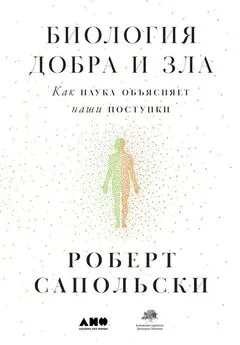
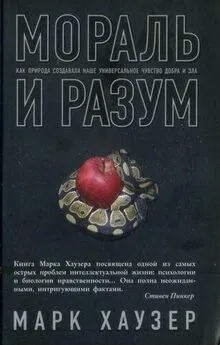
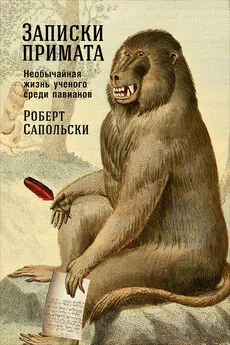


![Роберт Сапольски - Игры тестостерона и другие вопросы биологии поведения [litres]](/books/1074102/robert-sapolski-igry-testosterona-i-drugie-vopros.webp)
